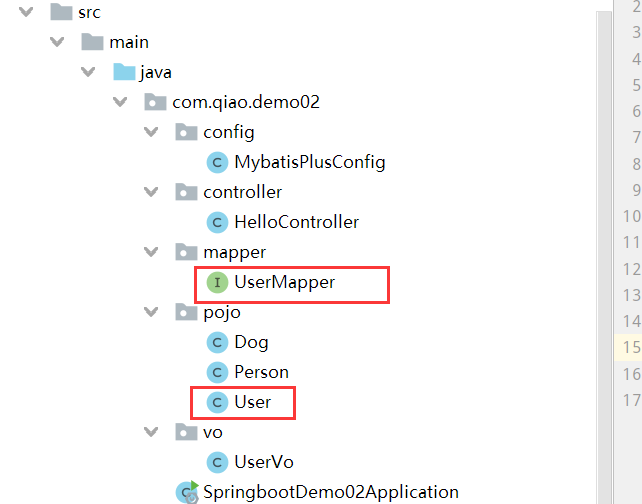您好,登录后才能下订单哦!
今天就跟大家聊聊有关使用mybatis-plus如何实现分页查询功能,可能很多人都不太了解,为了让大家更加了解,小编给大家总结了以下内容,希望大家根据这篇文章可以有所收获。
引入依赖:
<!-- 引入mybatisPlus --> <dependency> <groupId>com.baomidou</groupId> <artifactId>mybatis-plus-boot-starter</artifactId> <version>3.2.0</version> </dependency> <!-- 引入mysql驱动包 --> <dependency> <groupId>mysql</groupId> <artifactId>mysql-connector-java</artifactId> <version>5.1.27</version> </dependency> <!-- 引入Druid依赖,阿里巴巴所提供的数据源 --> <dependency> <groupId>com.alibaba</groupId> <artifactId>druid</artifactId> <version>1.0.29</version> </dependency>
在application.yml配置
spring: datasource: type: com.alibaba.druid.pool.DruidDataSource driver-class-name: com.mysql.jdbc.Driver url: jdbc:mysql://127.0.0.1:3306/test?useUnicode=true&characterEncoding=UTF-8 username: root password: 123456
在启动类上面添加@MapperScan注解,扫描mapper包
@SpringBootApplication
@MapperScan("com.qiao.demo02.mapper")
public class SpringbootDemo02Application {
public static void main(String[] args) {
SpringApplication.run(SpringbootDemo02Application.class, args);
}
}新建User和UserMapper

user类
@Data
public class User {
@TableId
private Integer userId;
private String userName;
private Integer userAge;
private String userEmail;
}UserMapper接口
public interface UserMapper extends BaseMapper<User> {
}最重要的是继承BaseMapper<E>接口:里面声明了很强大的CRUD方法
public interface BaseMapper<T> extends Mapper<T> {
int insert(T entity);
int deleteById(Serializable id);
int deleteByMap(@Param("cm") Map<String, Object> columnMap);
int delete(@Param("ew") Wrapper<T> wrapper);
int deleteBatchIds(@Param("coll") Collection<? extends Serializable> idList);
int updateById(@Param("et") T entity);
int update(@Param("et") T entity, @Param("ew") Wrapper<T> updateWrapper);
T selectById(Serializable id);
List<T> selectBatchIds(@Param("coll") Collection<? extends Serializable> idList);
List<T> selectByMap(@Param("cm") Map<String, Object> columnMap);
T selectOne(@Param("ew") Wrapper<T> queryWrapper);
Integer selectCount(@Param("ew") Wrapper<T> queryWrapper);
List<T> selectList(@Param("ew") Wrapper<T> queryWrapper);
List<Map<String, Object>> selectMaps(@Param("ew") Wrapper<T> queryWrapper);
List<Object> selectObjs(@Param("ew") Wrapper<T> queryWrapper);
IPage<T> selectPage(IPage<T> page, @Param("ew") Wrapper<T> queryWrapper);
IPage<Map<String, Object>> selectMapsPage(IPage<T> page, @Param("ew") Wrapper<T> queryWrapper);
}分页查询
这点官方文档讲的也很详细:https://mp.baomidou.com/guide/page.html
新建一个config包,在里面建一个MybatisPlus配置类 返回一个分页拦截器
package com.qiao.demo02.config;
@Configuration
@ConditionalOnClass(value = {PaginationInterceptor.class})
public class MybatisPlusConfig {
@Bean
public PaginationInterceptor paginationInterceptor() {
PaginationInterceptor paginationInterceptor = new PaginationInterceptor();
return paginationInterceptor;
}
}这样就能使用mybatis的分页功能了
Junit测试
@Resource
private UserMapper userMapper;
@Test
public void queryUserForPage(){
IPage<User> userPage = new Page<>(2, 2);//参数一是当前页,参数二是每页个数
userPage = userMapper.selectPage(userPage, null);
List<User> list = userPage.getRecords();
for(User user : list){
System.out.println(user);
}
}Controller返回json串
先定义一个包装类UserVo,用来保存分页所需要的数据
package com.qiao.demo02.vo;
@Data
public class UserVo {
private Integer current;
private Integer size;
private Long total;
private List<User> userList;
}然后在控制器编写代码,这里省略了service层,实际开发业务代码写在service层,Controller只负责:接受参数、调用service层方法处理业务逻辑,返回结果
Controller类贴上了@RestController注解
@GetMapping("queryUser")
public UserVo queryList(Integer current, Integer size) {
/**
* 这些代码应该写在service层
*/
UserVo userVo = new UserVo();
IPage<User> page = new Page<>(current, size);
userMapper.selectPage(page, null);
userVo.setCurrent(current);
userVo.setSize(size);
userVo.setTotal(page.getTotal());
userVo.setUserList(page.getRecords());
return userVo;
}附上结果,前端直接处理json数据即可

看完上述内容,你们对使用mybatis-plus如何实现分页查询功能有进一步的了解吗?如果还想了解更多知识或者相关内容,请关注亿速云行业资讯频道,感谢大家的支持。
免责声明:本站发布的内容(图片、视频和文字)以原创、转载和分享为主,文章观点不代表本网站立场,如果涉及侵权请联系站长邮箱:is@yisu.com进行举报,并提供相关证据,一经查实,将立刻删除涉嫌侵权内容。